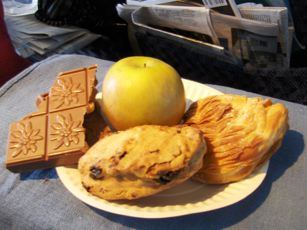
As many of us know, finding tasty, healthy and satisfying food on the road can be, well, a challenge. Between airlines that don’t even serve peanuts anymore, room service rip-offs and pricey hotel restaurants, how is a self-respecting foodie supposed to make do? David Latt shares some of his hints …
1. Cruising at 30,000 Feet and You’re Hungry, Now What?
Only a few airlines still offer complimentary in-flight food.
In coach, even peanuts and pretzels have disappeared.
You can buy food on the plane, but why spend $12 on a dried-out turkey sandwich?
If the trip takes you through a time zone, pack a meal. The day before the trip, stop at a local deli and pick up some treats. But don’t just pick up any pre-packaged junk food.
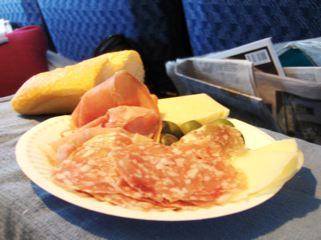 The trick is to plan your airline travel as if it’s a picnic: My favorite meal on a plane is a charcuterie plate, which includes a selection of meats, cheeses, olives, and a small baguette. For something sweet, simply pack an apple, a good piece of chocolate, and a small pastry. (A tip: bring a paper plate.) Your picnic will cost you less than buying sandwiches on the plane and the other passengers will envy your home-made meal.
The trick is to plan your airline travel as if it’s a picnic: My favorite meal on a plane is a charcuterie plate, which includes a selection of meats, cheeses, olives, and a small baguette. For something sweet, simply pack an apple, a good piece of chocolate, and a small pastry. (A tip: bring a paper plate.) Your picnic will cost you less than buying sandwiches on the plane and the other passengers will envy your home-made meal.
2. Let Someone Else Be the Hotel’s Profit Center
The cost of eating in a hotel is often pricey. I find it much more fun (and economical) to stop at a local store and pick up drinks and snacks.
When I travel I always carry something that won’t spoil like a bag of trail mix. (A tip: bring a Ziploc baggie with the trail mix, so once the original bag is opened you can use the baggie to seal it up—it stays fresh and doesn’t spill.)
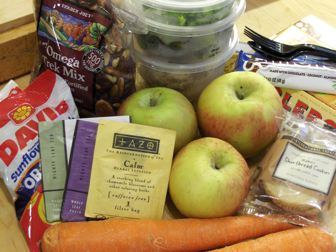 One of my favorite snacks is peanut butter and jelly on crackers. To make it portable, stop at a camping supply store and buy a set of refillable plastic tubes.
One of my favorite snacks is peanut butter and jelly on crackers. To make it portable, stop at a camping supply store and buy a set of refillable plastic tubes.
Pick up a package of crackers and you’ll be set if you get the munchies in the middle of the night.
3. See the Local Culture at the Farmers’ Markets
You’ve visited the museums and learned about the host country’s history, now go to a farmers’ market and experience the local culture in all its vibrancy. Farmers’ markets are the life blood of the city.
You’ll see tables piled high with fresh fruits, vegetables, meat, and seafood (when traveling in Havana, I was amazed at the size of the papayas!).
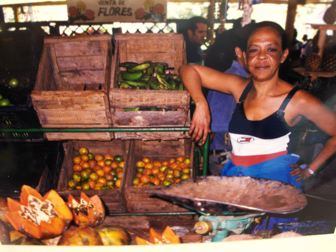 Many markets also sell prepared food and fresh drinks, which is often a great way to sample locals’ favorite treats. (Hint: Check with the local guide books to learn which foods and drinks are OK to eat—in some countries, you’ll want to stay away from uncooked fruits and vegetables).
Many markets also sell prepared food and fresh drinks, which is often a great way to sample locals’ favorite treats. (Hint: Check with the local guide books to learn which foods and drinks are OK to eat—in some countries, you’ll want to stay away from uncooked fruits and vegetables).
Markets often have displays of local crafts and clothing, art for sale, and even live music.
4. You’re Hungry and the Concierge Suggests the Outback Steakhouse Next Door
Where to eat? That’s the question in a new city. Many hotels have lists of suggested restaurants and sometimes they can be helpful, but ideally, a restaurant suggestion should come from someone you trust—someone who knows the city.
There are two ways to attack the problem. First and foremost, Google it. On my last visit to Boston, the concierge suggested PF Chang’s, a nice enough chain restaurant.
A quick Google search gave us a list of five restaurants nearby. We took a walking tour and picked one that looked good and wound up having a delicious meal. Secondly, get advice from friends. Send out an email telling them where you’re going and when. You’ll get a good list with their personal recommendations.
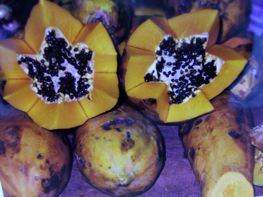 I have a third way, which I’ll mention with the caveat that this usually appeals only to the most compulsive of travelers: I confess to being a clipper-of-articles from magazines and the travel sections in the Sunday newspaper. I keep thick files with hotel and restaurant reviews for most major cities around the world. If you’re going to Vietnam, I know that Le Giang in Phu Quoc serves a great pho noodle soup or for a quintessential Napa Valley meal, eat at the Martini House in St. Helena.
I have a third way, which I’ll mention with the caveat that this usually appeals only to the most compulsive of travelers: I confess to being a clipper-of-articles from magazines and the travel sections in the Sunday newspaper. I keep thick files with hotel and restaurant reviews for most major cities around the world. If you’re going to Vietnam, I know that Le Giang in Phu Quoc serves a great pho noodle soup or for a quintessential Napa Valley meal, eat at the Martini House in St. Helena.
5. With a Little Help from Your Friends
Restaurants are fine. Hotels are lovely. But if you want to experience the culture of the city, have dinner in the home of a person who lives there.
When we traveled to Rio we had dinner with a friend. His wife prepared the dinner and his friends joined us. We sat on a deck that overlooked the city, eating all the local specialties and listening to the stories associated with each one. We arrived at 8 p.m. for cocktails and appetizers, but the meal didn’t start until 11 p.m. when Brazilians traditionally eat dinner (in fact, we didn’t get back to the hotel until after 3:00 a.m.!)
If you don’t have friends in the city you’ll be visiting, send an email asking your friends if they know people you could visit. When you get into town, call them, and hopefully they’ll invite you over for a nice home-cooked meal.
By David Latt for PeterGreenberg.com. David Latt is a television producer, world traveler and foodie who indulges in copious amounts of “cooking therapy.” See more of his musings on food, family and travel: https://menwholiketocook.blogspot.com
Don’t miss more foodie adventures in the Culinary Travel section. Here’s a taste of what you’ll find there:
Culinary Adventures: Discovering Secret Restaurants
Wine Shipping 101: Sorry, That’s a Felony












